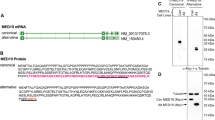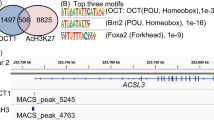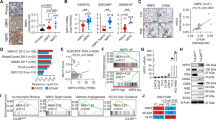Abstract
Neuroendocrine differentiation has been associated with prostate cancer (CaP). Brn-3a (short isoform) and Brn-3c, transcriptional controllers of neuronal differentiation, were readily detectable in human CaP both in vitro and in vivo. Brn-3a expression, but not Brn-3c, was significantly upregulated in >50% of tumours. Furthermore, overexpression of this transcription factor in vitro (i) potentiated CaP cell growth and (ii) regulated the expression of a neuronal gene, the Nav1.7 sodium channel, concomitantly upregulated in human CaP, in an isoform-specific manner. It is concluded that targeting Brn-3a could be a useful strategy for controlling the expression of multiple genes that promote CaP.
This is a preview of subscription content, access via your institution
Access options
Subscribe to this journal
Receive 4 print issues and online access
$259.00 per year
only $64.75 per issue
Buy this article
- Purchase on Springer Link
- Instant access to full article PDF
Prices may be subject to local taxes which are calculated during checkout





Similar content being viewed by others
References
Francis NJ, Kingston RE . Mechanisms of transcriptional memory. Nat Rev Mol Cell Biol 2001; 2: 409–421.
Varambally S, Dhanasekaran SM, Zhou M, Barrette TR, Kumar-Sinha C, Sanda MG et al. The polycomb group protein EZH2 is involved in progression of prostate cancer. Nature 2002; 419: 624–629.
Harris H . Putting on the brakes. Nature 2004; 427: 201.
Latchman DS . POU family transcription factors in the nervous system. J Cell Physiol 1999; 179: 126–133.
Xiang M, Zhou L, Macke JP, Yoshioka T, Hendry SH, Eddy RL et al. The Brn-3 family of POU-domain factors: primary structure, binding specificity, and expression in subsets of retinal ganglion cells and somatosensory neurons. J Neurosci 1995; 15: 4762–4785.
Morris PJ, Dawson SJ, Wilson MC, Latchman DS . A single residue within the homeodomain of the Brn-3 POU family transcription factors determines whether they activate or repress the SNAP-25 promoter. Neuroreport 1997; 8: 2041–2045.
Budhram-Mahadeo V, Parker M, Latchman DS . POU transcription factors Brn-3a and Brn-3b interact with the estrogen receptor and differentially regulate transcriptional activity via an estrogen response element. Mol Cell Biol 1998; 18: 1029–1041.
Budram-Mahadeo V, Morris PJ, Latchman DS . The Brn-3a transcription factor inhibits the pro-apoptotic effect of p53 and enhances cell cycle arrest by differentially regulating the activity of the p53 target genes encoding Bax and p21(CIP1/Waf1). Oncogene 2002; 21: 6123–6131.
Veenstra GJ, van der Vliet PC, Destree OH . POU domain transcription factors in embryonic development. Mol Biol Rep 1997; 24: 139–155.
McEvilly RJ, Rosenfeld MG . The role of POU domain proteins in the regulation of mammalian pituitary and nervous system development. Prog Nucleic Acid Res Mol Biol 1999; 63: 223–255.
Ndisdang D, Morris PJ, Chapman C, Ho L, Singer A, Latchman DS . The HPV-activating cellular transcription factor Brn-3a is overexpressed in CIN3 cervical lesions. J Clin Invest 1998; 101: 1887–1892.
Leblond-Francillard M, Picon A, Bertagna X, de Keyzer Y . High expression of the POU factor Brn3a in aggressive neuroendocrine tumors. J Clin Endocrinol Metab 1997; 82: 89–94.
Collum RG, Fisher PE, Datta M, Mellis S, Thiele C, Huebner K et al. A novel POU homeodomain gene specifically expressed in cells of the developing mammalian nervous system. Nucleic Acids Res 1992; 20: 4919–4925.
Lillycrop KA, Budeahan VS, Lakin ND, Tersenghi G, Wood JN, Polak JM et al. A novel POU family transcription factor is closely related to Brn-3 but has a distinct expression pattern in neuronal cells. Nucleic Acids Res 1992; 20: 5093–5096.
Turner EE, Jenne KJ, Rosenfeld MG . Brn-3.2: a Brn-3-related transcription factor with distinctive central nervous system expression and regulation by retinoic acid. Neuron 1994; 12: 205–218.
Budhram-Mahadeo V, Ndisang D, Ward T, Weber BL, Latchman DS . The Brn-3b POU family transcription factor represses expression of the BRCA-1 anti-oncogene in breast cancer cells. Oncogene 1999; 18: 6684–6691.
Leonard JH, Bell JR . Insights into the Merkel cell phenotype from Merkel cell carcinoma cell lines. Australas J Dermatol 1997; 38 (Suppl 1): S91–S98.
Leonard JH, Cook AL, Van Gele M, Boyle GM, Inglis KJ, Speleman F et al. Proneural and proneuroendocrine transcription factor expression in cutaneous mechanoreceptor (Merkel) cells and Merkel cell carcinoma. Int J Cancer 2002; 101: 103–110.
Theil T, McLean-Hunter S, Zornig M, Moroy T . Mouse Brn-3 family of POU transcription factors: a new aminoterminal domain is crucial for the oncogenic activity of Brn-3a. Nucleic Acids Res 1993; 21: 5921–5929.
Theil T, Zechner U, Klett C, Adolph S, Moroy T . Chromosomal localization and sequences of the murine Brn-3 family of developmental control genes. Cytogenet Cell Genet 1994; 66: 267–271.
DeCarvalho AC, Cappendijk SL, Fadool JM . Developmental expression of the POU domain transcription factor Brn-3b (Pou4f2) in the lateral line and visual system of zebrafish. Dev Dyn 2004; 229: 869–876.
Budhram-Mahadeo V, Moore A, Morris PJ, Ward T, Weber B, Sassone-Corsi P et al. The closely related POU family transcription factors Brn-3a and Brn-3b are expressed in distinct cell types in the testis. Int J Biochem Cell Biol 2001; 33: 1027–1039.
Smith MD, Ensor EA, Coffin RS, Boxer LM, Latchman DS . Bcl-2 transcription from the proximal P2 promoter is activated in neuronal cells by the Brn-3a POU family transcription factor. J Biol Chem 1998; 273: 16715–16722.
Budhram-Mahadeo V, Morris PJ, Lakin ND, Theil T, Ching GY, Lillycrop KA et al. Activation of the alpha-internexin promoter by the Brn-3a transcription factor is dependent on the N-terminal region of the protein. J Biol Chem 1995; 270: 2853–2858.
Bostwick DG, Qian J, Pacelli A, Zincke H, Blute M, Bergstralh EJ et al. Neuroendocrine expression in node positive prostate cancer: correlation with systemic progression and patient survival. J Urol 2002; 168: 1204–1211.
Hansson J, Abrahamsson PA . Neuroendocrine differentiation in prostatic carcinoma. Scand J Urol Nephrol 2003; 212 (Suppl): 28–36.
Laniado ME, Lalani EN, Fraser SP, Grimes JA, Bhangal G, Djamgoz MB et al. Expression and functional analysis of voltage-activated Na+ channels in human prostate cancer cell lines and their contribution to invasiveness in vitro. Am J Pathol 1997; 150: 1213–1221.
Diss JKJ, Archer SN, Hirano J, Fraser SP, Djamgoz MBA . Expression profiles of voltage-gated Na+ channel α-subunit genes in rat and human prostate cancer cell lines. The Prostate 2001; 48: 165–178.
Diss JKJ, Stewart D, Pani F, Foster CS, Walker MM, Patel A et al. A potential novel marker for human prostate cancer: voltage-gated sodium channel expression in vivo. Prostate Cancer Prostatic Dis 2005; 8: 266–273.
Diss JKJ, Fraser SP, Walker MM, Patel A, Latchman DS et al. Beta subunits of voltage-gated sodium channel: quantitative analyses of in vitro and in vivo expression in human prostate cancer. Prostate Cancer Prostatic Dis 2005 (submitted).
Fraser SP, Salvador V, Manning EA, Mizal J, Altun S, Raza M et al. Contribution of functional voltage-gated Na+ channel expression to cell behaviours involved in the metastatic cascade in rat prostate cancer. I. Lateral motility. J Cell Physiol 2003; 195: 479–487.
Mycielska ME, Djamgoz MBA . Cellular mechanisms of direct-current electric field effects: galvanotaxis and metastatic disease. J Cell Sci 2004; 117: 1631–1639.
Mycielska ME, Fraser SP, Szatkowski M, Djamgoz MB . Contribution of functional voltage-gated Na+ channel expression to cell behaviors involved in the metastatic cascade in rat prostate cancer: II. Secretory membrane activity. J Cell Physiol 2003; 195: 461–469.
Eng SR, Lanier J, Fedtsova N, Turner EE . Coordinated regulation of gene expression by Brn3a in developing sensory ganglia. Development 2004; 131: 3859–3870.
Kyprianou N, Bruckheimer EM, Guo Y . Cell proliferation and apoptosis in prostate cancer: significance in disease progression and therapy. Histol Histopathol 2000; 15: 1211–1223.
Krajewska M, Krajewski S, Epstein JI, Shabaik A, Sauvageot J, Song K et al. Immunohistochemical analysis of bcl-2, bax, bcl-X, and mcl-1 expression in prostate cancers. Am J Pathol 1996; 148: 1567–1576.
Cornford PA, Dodson AR, Parsons KF, Desmond AD, Woolfenden A, Fordham M et al. Heat shock protein expression independently predicts clinical outcome in prostate cancer. Cancer Res 2000; 60: 7099–7105.
Berthon P, Dimitrov T, Stower M, Cussenot O, Maitland NJ . A microdissection approach to detect molecular markers during progression of prostate cancer. Br J Cancer 1995; 72: 946–951.
Bhargava AK, Li Z, Weissman SM . Differential expression of four members of the POU family of proteins in activated and phorbol 12-myristate 13-acetate-treated Jurkat T cells. Proc Natl Acad Sci USA 1993; 90: 10260–10264.
Corcoran NM, Costello AJ . Interleukin-6: minor player or starring role in the development of hormone-refractory prostate cancer? BJU Int 2003; 91: 545–553.
Ndisang D, Budhram-Mahadeo V, Latchman DS . The Brn-3a transcription factor plays a critical role in regulating human papilloma virus gene expression and determining the growth characteristics of cervical cancer cells. J Biol Chem 1999; 274: 28521–28527.
Ndisang D, Budhram-Mahadeo V, Pedley B, Latchman DS . The Brn-3a transcription factor plays a key role in regulating the growth of cervical cancer cells in vivo. Oncogene 2001; 20: 4899–4903.
Schade SD, Brown CB . Identifying the promoter region of the human brain sodium channel subtype II gene (SCN2A). Mol Brain Res 2000; 81: 187–190.
Poiraud E, Gruszczynski C, Porteu A, Cambier H, Escurat M, Koulakoff A et al. The Na-G ion channel is transcribed from a single promoter controlled by distinct neuron- and schwann cell-specific DNA elements. J Neurochem 1999; 73: 2575–2585.
Kraner SD, Rich MM, Kallen RG, Barchi RL . Two E-boxes are the focal point of muscle-specific skeletal muscle type 1 Na+ channel gene expression. J Biol Chem 1998; 273: 11327–11334.
Sheng ZH, Zhang H, Barchi RL, Kallen RG . Molecular-cloning and functional-analysis of the promoter of rat skeletal-muscle voltage-sensitive sodium-channel subtype-2 (rskm2) – evidence for muscle-specific nuclear-protein binding to the core promoter. DNA Cell Biol 1994; 13: 9–23.
Yang P, Kupershmidt S, Roden DM . Cloning and initial characterization of the human cardiac sodium channel (SCN5A) promoter. Cardiovasc Res 2004; 61: 56–65.
Chong JHA, Tapia-Ramirez J, Kim S, Toledo-Aral JJ, Zheng Y, Boutros MC et al. REST – a mammalian silencer protein that restricts sodium-channel gene-expression to neurons. Cell 1995; 80: 949–957.
Fraser SP, Diss JK, Chioni AM, Mycielska ME, Pan H, Yamaci RF et al. Voltage-gated sodium channel expression and potentiaion of human breast cancer metastasis. Clin Can Res 2005; 11: 1–9.
Westbrook TF, Martin ES, Schlabach MR, Leng Y, Liang AC, Feng B et al. A genetic screen for candidate tumor suppressors identifies REST. Cell 2005; 121: 837–848.
Fraser SP, Diss JK, Lloyd LJ, Pani F, Chioni AM, George AJ et al. T-lymphocyte invasiveness: control by voltage-gated Na+ channel activity. FEBS Lett 2004; 569: 191–194.
Irshad S, Pedley RB, Anderson J, Latchman DS, Budhram-Mahadeo V . The Brn-3b transcription factor regulates the growth, behaviour and invasiveness of human neuroblastoma cells in vitro and in-vivo. J Biol Chem 2004; 279: 21617–21627.
Smith MD, Melton LA, Ensor EA, Packham G, Anderson P, Kinloch RA et al. Brn-3a activates the expression of Bcl-x(L) and promotes neuronal survival in vivo as well as in vitro. Mol Cell Neurosci 2001; 17: 460–470.
Lee SA, Ndisang D, Patel C, Dennis JH, Faulkes DJ, D'Arrigo C et al. Expression of the Brn-3b transcription factor correlates with expression of HSP-27 in breast cancer biopsies and is required for maximal activation of the HSP-27 promoter. Cancer Res 2005; 65: 3072–3080.
Acknowledgements
We would like to thank Professor Norman Maitland (supported by Yorkshire Cancer Research) for the PNT2-C2 cell line, Dr Scott Fraser, Dr Saleha Farooqui, Dr Shazia Irshad and Peter Morris for technical assistance, and Dr Duncan Gascoyne, Dr Yalda Jamshidi and Dr Laila Samady for useful discussions.
Author information
Authors and Affiliations
Corresponding author
Rights and permissions
About this article
Cite this article
Diss, J., Faulkes, D., Walker, M. et al. Brn-3a neuronal transcription factor functional expression in human prostate cancer. Prostate Cancer Prostatic Dis 9, 83–91 (2006). https://doi.org/10.1038/sj.pcan.4500837
Received:
Accepted:
Published:
Issue Date:
DOI: https://doi.org/10.1038/sj.pcan.4500837
Keywords
This article is cited by
-
Molecular analysis of oncogenicity of the transcription factor, BRN3A, in cervical cancer cells
Journal of Cancer Research and Clinical Oncology (2011)



